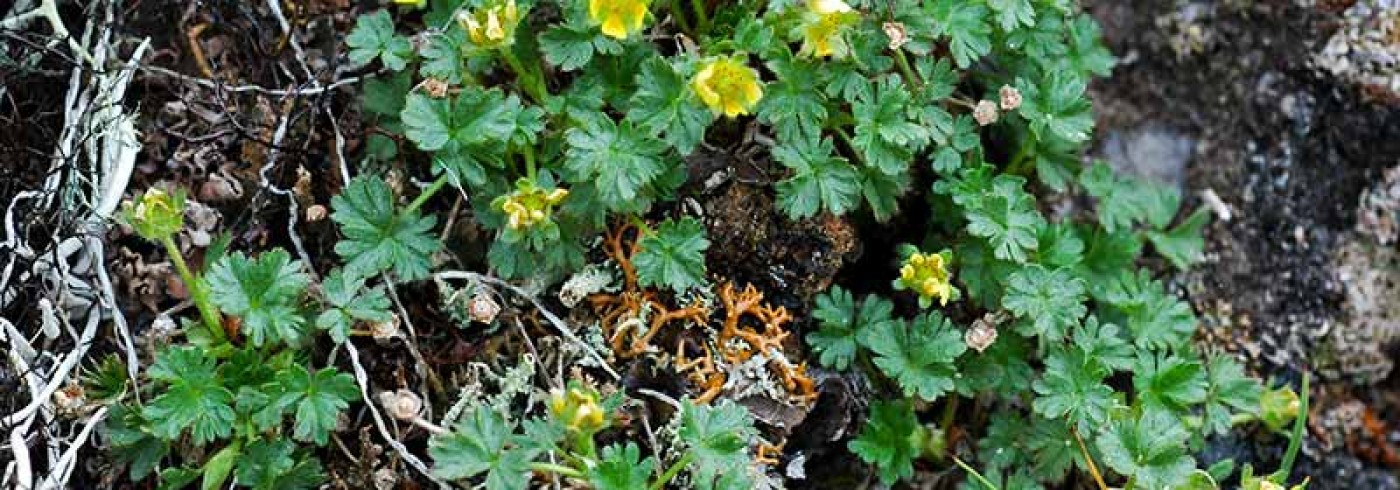Genetic biogeography and clonality in the bryophyte Hylocomium splendens
Molecular techniques make it possible to quantify infraspecific genetic diversity within plants and animals. This knowledge can help us to answer important questions about the life history and evolution of organisms. Until recently almost all knowledge about genetic diversity has come from species living in the temperate zone. This is unfortunate since Arctic organisms for several reasons are likely to have different short-term and long-term evolutionary histories. For example:
- Arctic climates have only existed for ca. 2 million years, which is a short period of time in an evolutionary perspective.
- The harsh climate imposes constraints on the reproductive processes.
- The organisms living in the Arctic areas are likely to have survived the Pleistocene glaciations in refugia which are currently poorly defined as compared to the more southerly refugia of temperate zone organisms.
Mosses are dominant components of the vegetation in a wide range of Arctic habitats. The moss, Hylocomium splendens B.S.G. (”feather moss”), is one of the most abundant plant species of northern hemisphere boreal forests and tundra ecosystems, where it grows in loose carpets. The shoots can branch and proliferate vegetatively to form colonies consisting of a single genotype, a clone. On the Tundra Northwest 1999 expedition populations of H. splendens were collected from 7 sites representing both the latitudinal and longitudinal gradients. This material will be analysed using morphological methods (computerized image analysis) and molecular methods (isozymes and DNA-sequencing).
Circumpolar pattern of differentiation
The first goal of the sampling on the Tundra Northwest 1999 expedition is to complete a circumpolar study of the genetic differentiation of Arctic populations. Material from Siberia (collected during the 1994 expedition), Scandinavia, Spitzbergen and Greenland has earlier been screened for genetic variation (isozymes). The 5-10% of the total variation that is informative at this level shows clear geographic trends. It has up to now been possible to identify three or four different ”races” with different distribution areas and different histories of glacial survival. Together with morphological data this study is also expected to shed light on the genetic background of the taxonomic confusion regarding H. splendens and the morphologically deviating Arctic plants sometimes referred to as H. alaskanum.
Levels of within-population variation
An unexpected result from the Siberian expedition was that all populations were highly variable. Climate did not restrict the level of variation despite the fact that successful sexual reproduction appeared to be extremely rare due to low mean summer temperatures. Material from Tundra northwest 1999 confirms the observation that sexual reproduction is rare. Individual clones are probably very long-lived so that variation is maintained in populations despite the lack of sexual reproduction.
The western sites, including the Ivvavik and S Banks Island sites, are situated in the Beringian area that was never glaciated during the last glaciation. It should be possible to trace migration routes from the glacial refugia into the formerly glaciated areas. Genetic variation is expected to have been lost during this process. However, only a small difference in genetic variability was detected between populations from formerly glaciated versus unglaciated areas collected on the Siberian expedition. Material from the western Arctic, with a quite different glacial history, will put this expectation to a new test.
Clonal fragmentation
The clonal structure of Hylocomium is largely unknown. Are there only a small number of clones that are dominant over vast areas? How efficient is the vegetative dispersal? Mosses have no roots but absorb most of the nutrients directly from precipitation and melt water. A branch which has become detached from the main shoot can therefore readily start to grow in a new place given suitable conditions. Results from the 1994 Siberian expedition show that populations are multiclonal and that surprisingly the clones are strongly fragmented, perhaps as a result of dispersal mediated by lemmings using moss shoots for food and for building material for nests.
Retrospective growth analysis
Hylocomium’s habit of growing in segmental chains makes it possible to compare the growth of past years. The length of the annual growth has been shown to be primarily dependent on the climatic conditions. Proffesor Terry Callaghan is responsible for this part of the programme, which is an extension of his earlier studies dealing with circum-Arctic retrospective analysis of H. splendens. These studies of variation in time are expected to supplement the studies of variation in space described above.
Dates
June–September 1999
Participants
Principal investigator
Nils Cronberg
Department of Systematic Botany, Lund University
Sweden
Terry V. Callaghan*
Sheffield Centre for Arctic Ecology
Department of Animal and Plant Sciences, University of Sheffield
United Kingdom
*Not participating in the expedition

